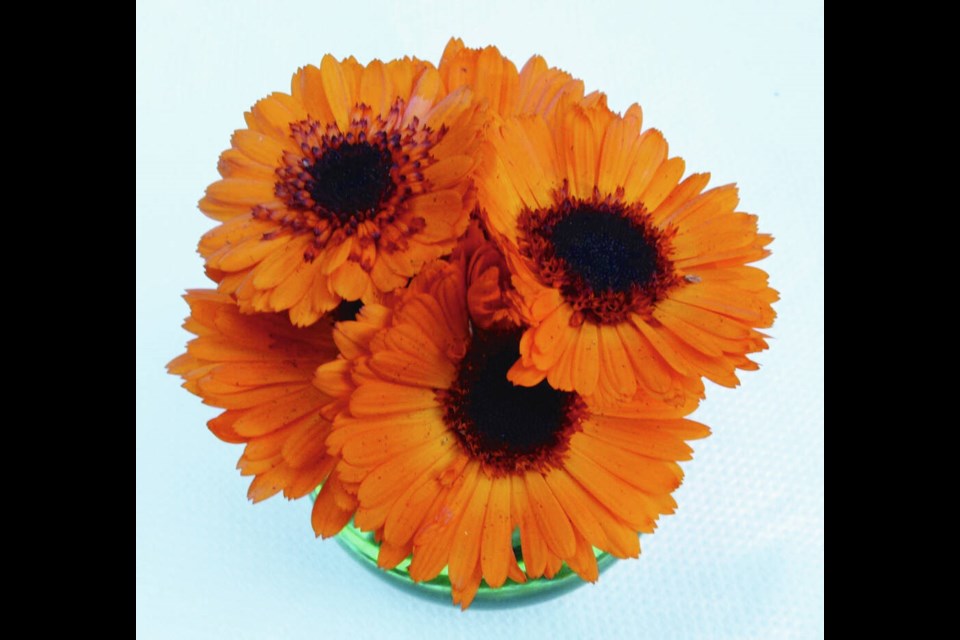Dear Helen: Aren’t calendula blooms orange? This past summer, a friend identified a flower in her garden as calendula, but the blooms were a lemony-white.
C.B.
There are dozens of named calendula varieties. Among them are single, double, and semi-double flowers in orange, yellow, cream, buff, and colour combinations. Neon had fully double flowers with orange petals tipped in burgundy. Snow Princess is yellow in bud, opening to almost white with a dark or yellow centre. Crown Orange looks almost like a Gerbera with colour rings of apricot to orange toward a dark centre. These three varieties are from W.H. Perron.
Orange Button, from Johnny’s Selected Seeds (JSS), is a beauty in vibrant orange with a purple-black centre. New in the 2022 JSS catalogue is Ivory Princess, a dark-centred flower in cream and gold.
A European Fleuroselect trial of over 80 varieties was conducted last year in the Royal Horticultural Society’s garden at Hyde Hall, UK. Visitors were asked to state their favourites. The top choice was Candyman Orange, a variety featuring large double blooms in bright orange on 30-cm, branched stems. Seed sources are T&T Seeds and Veseys Seeds.
Calendulas are easy-growing, traditional cottage garden flowers. They brighten vegetable plots and are excellent cut flowers. They can be seeded outdoors early, in March. Most varieties self-sow freely. Plants can be seen in bloom close to year round in our climate.
A common name for calendula is pot marigold, from a time when soups and stews were considered incomplete without the incorporation of calendula petals, which were used commonly in place of the far more expensive saffron. The petals also brighten salads, and they are used as a colourant.
Dear Helen: I have a forsythia that has not been pruned in the past few years. It is overgrown, congested, and unshapely. Is it all right to prune it now?
F.S.
Pruning now would remove stems that will bloom early in the spring. The usual time for pruning forsythia is right after the blossoms fade. There is the option also of pruning while gathering flower-laden stems for the house.
Remove damaged and dead growth, stems heading in toward the centre of the shrub and those in awkward positions. Thin out congested growth to allow sunlight penetration and free circulation of air through the shrub. Shorten overlong growth. Step back often through the pruning process, to assess the shape you are creating.
Dear Helen: I want next year’s vegetable plots to yield as much nutritious food as possible for my family. What are considered the most nutritious vegetables? I’m wondering especially about lettuce. Does one type have superior nutrition levels?
H.F.
Vegetables in general, especially when grown on fertile soil rich in organic matter, are good sources of fibre and a range of vitamins and minerals. When choosing from among highly nutritious vegetables to grow, keep in mind the family’s preferences. Best to grow food they will actually eat.
Staples of a healthy diet are dark green leafy vegetables like spinach and kale. They both give excellent nutritional value for the space they take in a garden plot. Among the lettuces, the romaines are considered a superior source of vitamins, minerals and anti-oxidants. They are a good source of folate, potassium, beta-carotene and lutein.
Vividly coloured vegetables like broccoli, red cabbage, sweet potatoes, beets and carrots all signal with their colouring high levels of nutrients and anti-oxidants.
Peas — green peas, snow peas and snap peas — are good sources of essential vitamins, minerals and anti-oxidants. Green peas are one of my main vegetable crops. I freeze enough most years to see me through late spring in the following year.
Frozen peas maintain their nutrient levels well if they are blanched only lightly, without the use of much water. I steam-blanche my peas briefly, just until their colour darkens, over water with mint stems in it. Then I cool them rapidly over freezer packs before packaging them in serving size portions.
Consumption of broccoli, cabbage and other cabbage family vegetables has been consistently linked with a lowered risk of many cancers.
Garlic delivers a multitude of benefits for the space it takes in a garden. It helps to reduce inflammation, boosts the immune system, and contributes to cardiovascular health. Incorporating freshly grated garlic into salad dressings increases the health benefits of the salad and adds a zesty flavour as well.



